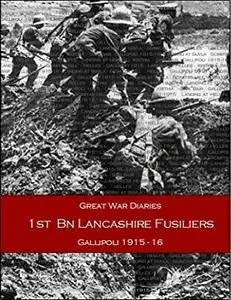Gallipoli Diaries: 2nd Bn Royal Fusiliers (City of London Regiment) by Adjutant Royal Fusiliers
English | 14 Oct. 2016 | ASIN: B01MAX6RLW | 116 Pages | PDF/MOBI/EPUB/PDF | 995.25 KB
English | 14 Oct. 2016 | ASIN: B01MAX6RLW | 116 Pages | PDF/MOBI/EPUB/PDF | 995.25 KB
The 2nd Bn Royal Fusiliers war diary - Gallipoli 1915-16. This diary is an accurate, meticulous transcription of the original Battalion diaries during the Gallipoli campaign. It is fully searchable.
At the outbreak of the Great War the 2nd Bn Royal Fusiliers was based in Calcutta, India. In January 1915 the Battalion landed in England, moving to Stockingford near Nuneaton where it was joined by other Regular battalions from the outposts of the British Empire. The 2nd Bn Royal Fusiliers formed part of the 86th Infantry Brigade, 29th Division which sailed for Egypt on 16th March 1915. The Battalion departed with a strength of 28 Officers and 962 Other Ranks destined for Mex Camp.
On 25th April 1915 the Royal Fusiliers landed at X Beach, Cape Helles, Gallipoli, at the start of the ill-fated campaign. The Battalion would stay in theatre for eight months and took part in some of the most brutal fighting on the peninsula. On 10th Oct 1915 the 29th Division took stock of its casualties to date and counted the number of ‘originals’ in each battalion who had landed on 25th April some six months earlier. Only 158 of the Royal Fusiliers 990 ‘originals’ answered the roll call. Of these most had been wounded or sick, evacuated, recovered and returned. Only 72 had never left the Gallipoli peninsula. There is no record of the number who struggled through to January 1916 when the Battalion was finally evacuated at the end of the disastrous campaign.
Fighting at Gallipoli was a fairly unique experience. With their backs to the sea the British forces were rarely out of danger. Most of the ‘rest areas’ were within the range of the Ottoman artillery and were constantly under threat. Artillery and artillery ammunition was in short supply on both sides, so the campaign did not experience the scale of bombardments seen on the Western Front. Despite this, danger came in many other forms.
The physical conditions were extreme. The masses of decaying corpses at the height of the Mediterranean summer became breeding grounds for plagues of flies. Few truces were arranged to bury bodies and the flies rapidly spread disease. Dysentery afflicted most men at some stage. Non-battle casualties were horrendous. During the height of the summer the Royal Fusiliers fought the bitter battles of Krithia on Cape Helles in squalid conditions.
In August 1915, after the stuttering progress of the New Army Divisions at the landings at Suvla Bay, elements of the 29th Division were sent to Suvla. The 2nd Bn Royal Fusiliers consequently took part in what was to be the largest offensive made during the whole campaign in the Battle of Scimitar Hill on 21st August 1915. It was a failure and was to be the last mass offensive action of the whole campaign.
As stalemate set in the blistering heat of the summer gave way to cooler weather, then rains and finally the winter. At the end of November a freak storm of hurricane force winds battered the peninsula. The Royal Fusiliers were by this stage entrenched in the flat diluvial plain of Suvla, mostly in what had been the dry river beds or nullahs. The British trench system was in the bottom of a natural bowl. The torrential rain triggered flash floods that burst the sandbag walls, drowning men and inundating the trenches.
Then the blizzard came. In less than a few hours the flood became a frozen lake, hammered by driving sleet and snow in sub-zero temperatures. Men were frozen to death and frost-bite created thousands of casualties. The day before the blizzard the 2nd Battalion stood at 691 All Ranks. Four days later the Battalion was reduced to just 68 All Ranks. Hardly a shot had been fired. Hundreds of men were hospitalized from this single battalion alone. The remnants of the Battalion held together for another month before being evacuated on 2nd January 1916.
The 2nd Bn Royal Fusiliers' Gallipoli diaries records their day-to-day experiences in one of the Great War's most controversial campaigns.



